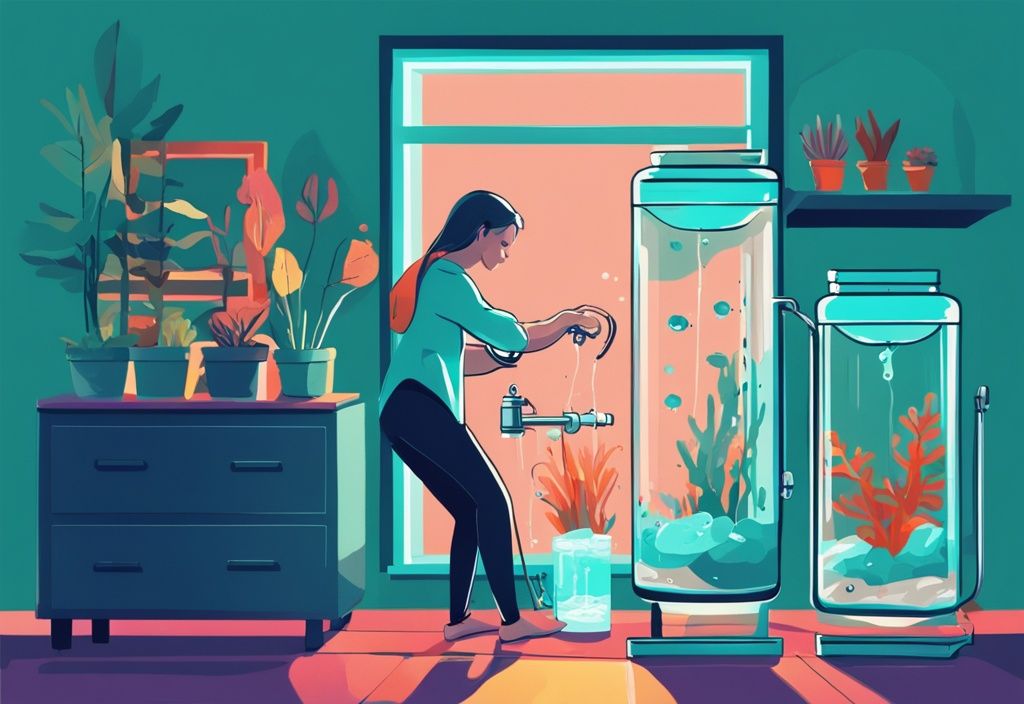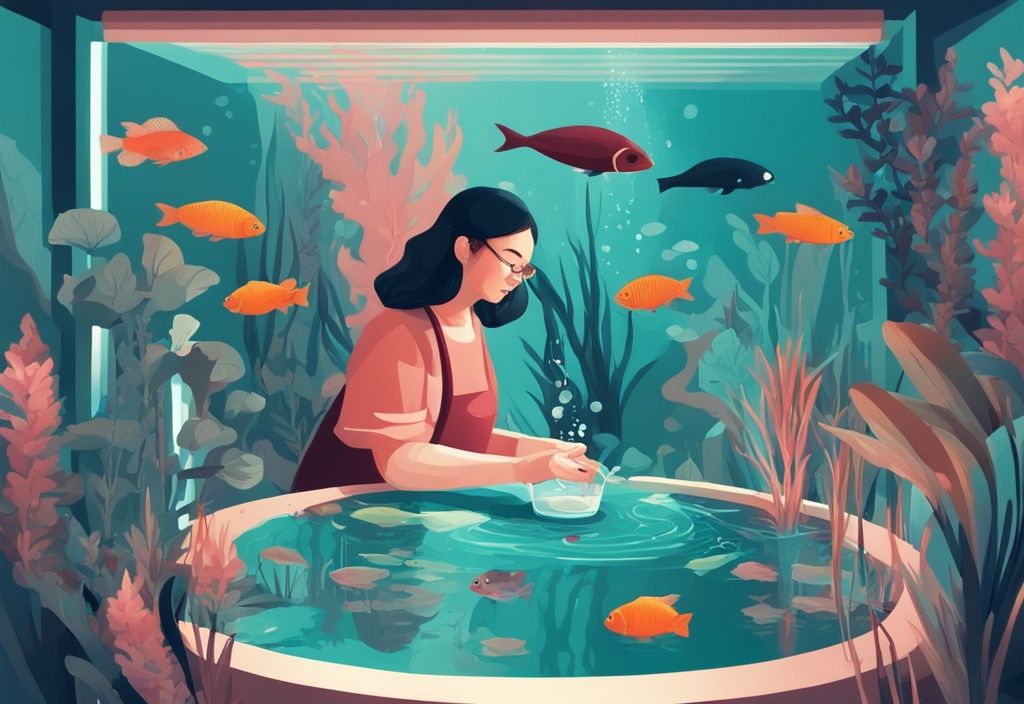Ever wondered what’s the secret ingredient to a vibrant and thriving aquarium? The answer might be simpler than you think: it’s water, but not just any kind. Adjusting the hardness levels of your aquarium water can make a significant difference to the health of your aquatic life. This comprehensive guide on how to soften aquarium water unlocks the secret.
Just like we humans need balanced diets for our well-being, your fish and plants require balanced water conditions to thrive. It’s not merely about feeding them; it’s about creating a perfect ecosystem that mimics their natural habitat. Luckily, it’s not a task only for the pros.
I’m here to guide you through each step towards achieving that perfect balance, ensuring that your marine friends enjoy a healthy, vibrant life. Embark on this enriching journey towards a stable and favorable environment for your aquarium life, leaving hard water troubles behind.
Understanding the Importance of Soft Water in Aquariums
When it comes to maintaining a harmonious and thriving aquarium, understanding the role of water softness can be vital. Soft water, which is characterized by low concentrations of dissolved minerals, particularly calcium and magnesium, can significantly influence the health and well-being of aquatic life. Let’s dive into the nitty-gritty of water hardness and why softening aquarium water is crucial for a balanced ecosystem.
What is Water Hardness?
Water hardness measures the concentration of dissolved minerals, primarily calcium and magnesium ions. High levels of these minerals result in hard water, while low concentrations yield soft water. The levels of water hardness hold considerable importance as they affect the overall environment within aquariums, impacting both fish and plant health.
Why Softening Water is Essential for Aquariums
Softening water, or reducing its mineral content, is essential for creating a suitable habitat in aquariums, particularly for species that naturally thrive in softer water conditions. Here are specific reasons why softening your aquarium water is vital:
- Suitable Habitat Creation: Many fish and aquatic plants originate from habitats that feature naturally soft water. Mirroring these conditions in your aquarium allows these species to flourish.
- Avoiding Stress: Stable water conditions are crucial to prevent stress-related health issues in fish. Sudden fluctuations in water hardness can be detrimental to their well-being.
- Species-Specific Needs: Different species of fish and plants have varying needs regarding water hardness. However, maintaining consistency in water conditions generally proves more beneficial than chasing exact hardness levels, fostering a stable and thriving environment for all inhabitants.
Understanding how to soften aquarium water and maintain its stability is a key part of responsible aquarium management, as poor water quality can lead to health issues in fish. For more insights on the importance of water quality in fishkeeping, check out this article on why water quality is such a big issue when it comes to fishkeeping. It’s essential for ensuring that your aquatic environment remains healthy and conducive to the well-being of all its inhabitants.
Practical Ways to Soften Your Aquarium Water
Softening aquarium water isn’t just about creating a more comfortable environment for your aquatic friends; it’s often a necessity for maintaining their health and well-being.
The following methods offer various approaches to adjusting water hardness to suit the specific needs of your fish and plants.
Using a RO/DI System to Soften Water
A reverse osmosis deionization (RO/DI) system is among the most effective techniques to soften aquarium water. This system works like a finely tuned sieve, filtering out nearly all particles, including minerals, to produce almost pure H2O. This is crucial for delicate aquatic life that thrives in soft water conditions. However, since fish and aquatic plants do require some minerals to survive, the pure water generated by the RO/DI system must be remineralized before being introduced into the aquarium. Typically, aquarists mix pure RO/DI water with their regular tap water to achieve the desired hardness, making this method both versatile and effective.
Softening Water with Distilled and Reverse Osmosis (R/O) Water
Using distilled water is another practical approach to reducing water hardness. Distilled water contains no minerals, making it an excellent base for creating softer water. By gradually mixing distilled water with tap water, aquarists can reduce hardness incrementally, minimizing stress on fish. However, distilled water also lacks vital electrolytes.

Therefore, you may need to add buffers to reach the desired pH and KH levels. One common practice is to use a ratio of approximately 30% distilled water to 70% tap water. When topping off due to evaporation, distilled or RO water suffices. Installing a small RO unit can ensure a continuous supply of softened water, making maintenance more convenient.
How to Soften Water with Aquarium Soil
Aquarium soil, especially those used in planted tanks, can also serve as an excellent medium for softening water. These substrates often have a natural buffering capacity, maintaining the tank’s pH below 7 and helping reduce water hardness. Additionally, the soil provides essential nutrients that contribute to the overall health and growth of aquatic plants. This method not only softens the water but also promotes a holistic environment conducive to thriving aquarium ecosystems.
Utilizing Driftwood for Water Softening
Driftwood offers a natural way to soften aquarium water. As driftwood remains submerged, it releases tannins over time, which helps reduce water hardness and lower the pH. However, tannins can tint water a brownish color, which some aquarists may find undesirable. To mitigate this effect, it’s advisable to boil the driftwood before adding it to the aquarium. Boiling not only lessens the discoloration but also ensures the wood is sterilized, eliminating potential contaminants.
Beneficial Sources of Tannins for Water Softening
Besides driftwood, various other natural elements can release tannins to soften water. Catappa leaves, also known as Indian almond leaves, alder cones, and peat moss are excellent sources. These items gradually release tannins into the water, which lowers both pH and hardness.
Regular additions of these materials can help maintain stable and consistent water conditions, benefiting both fish and plants by closely mimicking their natural habitats. By incorporating these practices, you can create a more sustainable and balanced ecosystem within your aquarium.
Adding Natural Elements for Water Softening
Peat moss and water softening pillows are among the most effective natural solutions for reducing the hardness of aquarium water. Exploring these methods can help establish a balanced aquatic environment that benefits both fish and plant life.
Using Peat Moss in Filters to Soften Water
Peat moss, a natural marvel, offers a highly effective way to soften your aquarium water. When added to the filtration system or as a substrate, it releases beneficial tannins. These tannins interact with minerals like calcium and magnesium, neutralizing their hardness impact. Besides softening the water, tannins also lower the pH level, closely mimicking the natural habitats of many tropical fish species.
To integrate peat moss into your aquarium, simply place it directly in the filter media. This method provides a gradual release of tannins, ensuring stable water conditions. It’s important to avoid rapid changes, which could stress your aquatic life. Using peat moss is both an eco-friendly and natural solution for those wondering how to soften aquarium water gently and sustainably.
Role of Water Softening Pillows in Aquariums
Water softening pillows serve as handy tools filled with ion-exchange resins, specifically designed to remove hardness-causing minerals from your aquarium water. When these pillows are placed either in the tank or the filter, the resins effectively capture calcium and magnesium ions, softening the water in the process.
However, it’s crucial to monitor the rate at which water hardness reduces, as rapid changes can stress fish and other aquatic inhabitants. For optimal results, use softening pillows intermittently. This approach gives you control over the reduction rate, maintaining consistent water parameters. Regular monitoring and adjustments ensure a healthy and stable environment for your aquatic residents while reaping the benefits of softened water.
Whether you choose peat moss or water softening pillows, consistently monitoring your aquarium’s water conditions is key to successfully learning how to soften aquarium water. Experimenting with these natural elements can greatly enhance your tank’s ecosystem, promoting a healthy, vibrant habitat for your aquatic life.
Using Water Conditioning and Chemical Adjustments
For those interested in understanding how to soften aquarium water, exploring various techniques such as water conditioning and chemical adjustments is essential. These methods target the reduction of water hardness, ensuring a stable and healthy aquatic environment.

How Tap Water Conditioner Helps in Softening Water
When it comes to how to soften aquarium water, commercial water conditioners are your best friend. These products are formulated to neutralize harmful mineral ions like calcium and magnesium found in tap water, which are the main culprits behind high water hardness.
By minimizing these minerals, water conditioners make your tap water softer and more conducive to the health of various fish species. Besides this primary function, they also excel in removing chlorine and chloramines. This additional benefit is crucial for both fish and plants in your aquarium.
Consistency is key. Regular use of water conditioners during water changes keeps your tank conditions stable. Stable conditions are less stressful for your aquatic inhabitants, helping them thrive. Think of it as a routine health check-up for your aquarium ecosystem, ensuring everything runs smoothly.
Implementing Chemical Adjustments in Aquarium Water Softening
Another avenue worth exploring for those learning how to soften aquarium water involves chemical adjustments. Several commercial products on the market are designed specifically to lower water hardness through chemical means.
However, caution is paramount when using chemical softeners as they can induce rapid changes in water chemistry, including pH levels. Improper use may harm your fish, stressing their delicate systems. Thus, adhering strictly to the manufacturer’s instructions and introducing these chemicals gradually into your tank is vital.
Regular monitoring of your water parameters is equally critical to ensure the changes don’t adversely affect your fish or disrupt the existing biological balance. Approach chemical treatments with a slow and steady hand, prioritizing the health and well-being of your aquarium’s ecosystem.
Other Water Softening Tips
Collecting and Using Rainwater for Aquarium
Rainwater is an exceptional source of naturally soft water, and it’s a real gem for anyone aiming to soften their aquarium water. However, it’s vital to filter the rainwater meticulously to eliminate pollutants and algae before it graces your tank. Introducing unfiltered rainwater can inadvertently introduce harmful substances, causing distress to your beloved fish and plants. Filtering is just the first step—restoring essential minerals to rainwater is paramount for stabilizing KH levels. This process plays a crucial role in preventing abrupt pH changes, which can be quite stressful for your aquatic friends. Gradually incorporating rainwater and frequently monitoring its impact ensures a stable and nurturing environment for all your aquatic inhabitants.
Maintaining Stability in Your Aquarium
Ensuring stable water conditions is the cornerstone of a thriving aquarium ecosystem. Persistent fluctuations in water hardness and pH levels can exert undue stress on fish, leading to various health challenges. Interestingly, fish are remarkably adept at adapting to stable conditions, even if it doesn’t precisely match their ideal water hardness.
Regularly testing water hardness and pH levels lays the groundwork for this stability. Maintaining consistency in water parameters is crucial, as it fosters a healthy environment where fish and plants can flourish. When making adjustments, opt for small, gradual changes over drastic ones to evade unnecessary stress and keep your aquarium’s balance intact.
Importance of Regular Water Testing and Changes
Regular water testing and changes form the backbone of effective aquarium maintenance. The natural processes within your tank—such as fish waste and decaying plant matter—gradually increase water hardness over time. Consistent water changes are essential to counteract this accumulation, keeping the environment balanced.
It’s recommended to test water hardness and pH levels at least weekly, especially if you’re actively working on softening the water. Maintaining a consistent water hardness level is imperative, as fluctuations can disrupt the pH balance, resulting in stress for your fish. By committing to regular testing and diligent water changes, you ensure a stable and healthy habitat for all your tank’s inhabitants.

Conclusion: Achieving Optimal Hardness Levels
Adapting to Different Water Conditions
Fish typically adapt better to a stable environment, even if the specific water hardness isn’t perfect. Reliable and consistent water parameters prevent stress and health issues in fish, making stability paramount.
While the ideal water hardness varies by species, maintaining a steady environment is frequently more crucial than pursuing exact values. Gradual changes in hardness help fish adapt smoothly and avoid potentially harmful spikes in water chemistry.
For those wondering how to soften aquarium water, a focus on gradual adjustments ensures fish friendliness.
Recommended Hardness Levels for Various Aquarium Species
Each species of aquarium fish has its own unique preference for water hardness, often corresponding to their natural habitats. For instance:
- Tetras: These fish generally prefer softer water, with a guideline of around 2-10 dH (degrees of hardness). Imagine Tetras swimming peacefully in softer waters, mirroring their Amazonian roots.
- Discus: Known for their sensitivity, discus fish thrive in very soft water, typically between 1-4 dH. Think of Discus as the refined gourmets of the fish world, relishing the delicate softness of the water.
- Guppies: These adaptable fish can tolerate a broader range, but their natural habitats suggest 8-12 dH for optimal health. Visualize Guppies as the versatile adventurers, comfortable in various conditions but flourishing in slight hardness.
- Snails and Shrimp: These invertebrates usually prefer harder water due to their need for calcium, ranging from 10-20 dH. Picture these critters as little architects, constructing their shells and exoskeletons from the calcium-rich waters.
Maintaining optimal hardness levels tailored to specific species not only supports vibrant health and coloration but also promotes natural behaviors and breeding success.
Understanding how to soften aquarium water and maintaining a balance in hardness levels ensures a thriving and stress-free aquatic environment for both fish and plants. This holistic approach benefits the overall well-being of your aquarium ecosystem and adds to the joy of fishkeeping.
FAQs on Softening Aquarium Water
Softening aquarium water can be a nuanced process, involving various techniques and considerations. Below, I’ll walk you through frequently asked questions on how to soften aquarium water, offering insights that blend scientific expertise with practical advice.
Can I use bottled water to soften the water in my aquarium?
Yes, you can use bottled water, but it’s essential to verify the mineral content first. Often, bottled water contains minerals that might require adjustments. Keep in mind, though, that using bottled water for your aquarium over the long term might not be the most sustainable or economical choice.
How often should I test the hardness of my aquarium water?
Regular testing is crucial for maintaining a balanced and healthy environment for your aquatic life. Test your aquarium water at least once a week or after any water changes. During significant adjustments to water hardness, more frequent testing is advisable to ensure stability.
Will the process of water softening adversely affect my aquarium plants?
The impact of water softening on aquarium plants varies based on the plant species. While some plants prefer softer water conditions, others may thrive better in harder water. To minimize stress, introduce changes gradually, allowing your plants to adapt without shock.
What is the safe pace to soften the water without stressing my fish?
To avoid stressing your fish, it is best to make gradual adjustments over several weeks. This slow pace allows the fish to acclimate smoothly and helps maintain stable water chemistry, fostering a healthy environment. Rapid changes can disrupt the delicate balance of your aquarium ecosystem.
